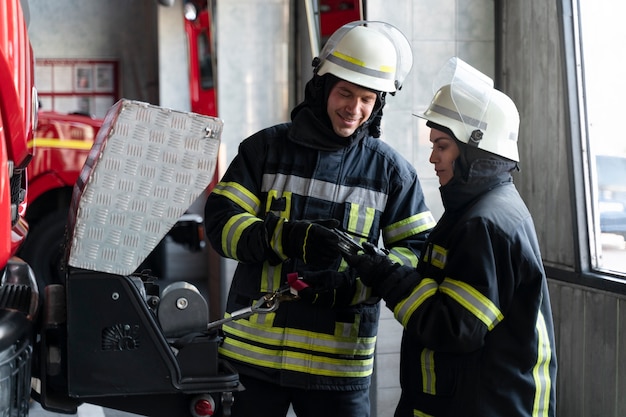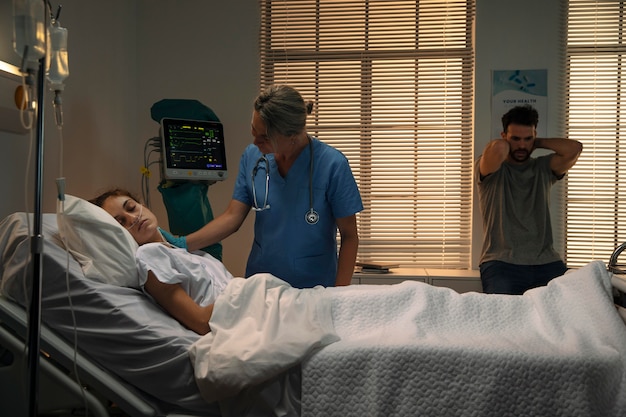In this article we will learn the Fire Safety Scenarios in Indian Hospitals. Fire safety is a critical aspect of healthcare facility management, particularly in Indian hospitals where the risk factors can be diverse and complex. As healthcare providers strive for excellence in patient care, ensuring compliance with the stringent standards set by the National Accreditation Board for Hospitals & Healthcare Providers (NABH) is paramount.
In this series of articles, we delve into various fire safety scenarios commonly encountered in Indian hospitals, highlighting the challenges they pose and offering practical strategies to ensure compliance with NABH standards. From electrical fire hazards to evacuation challenges, each scenario underscores the importance of proactive risk management and robust safety protocols of Fire Safety Scenarios in Indian Hospitals.
By examining these scenarios through the lens of NABH accreditation requirements, healthcare administrators, facility managers, and staff can gain valuable insights into enhancing fire safety preparedness, protecting lives, and safeguarding the integrity of healthcare operations of Fire Safety Scenarios in Indian Hospitals.
Join us as we explore these scenarios and navigate the complex landscape of fire safety in Indian hospitals, with a focus on meeting the rigorous standards set forth by NABH. Together, let us strive to create safer environments for patients, staff, and visitors, ensuring that every healthcare facility upholds the highest standards of safety and quality care of Fire Safety Scenarios in Indian Hospitals.

Scenario 1: Electrical Fire Hazard of Fire Safety Scenarios in Indian Hospitals
– Description of a scenario involving an electrical fire caused by faulty wiring or overloaded circuits of Fire Safety Scenarios in Indian Hospitals.
Description:
In a bustling Indian hospital, the day starts like any other. Patients are being treated, staff are attending to their duties, and the facility hums with activity. Suddenly, chaos erupts as smoke billows from a utility closet, accompanied by the acrid smell of burning plastic. Fire Safety Scenarios in Indian Hospitals.
Investigation reveals that the cause of the fire is traced back to faulty wiring in the closet, exacerbated by overloaded circuits due to the increased demand for electrical power. Fire Safety Scenarios in Indian Hospitals,The aging infrastructure, coupled with the strain of modern medical equipment, has led to a dangerous situation that puts patients, staff, and valuable medical resources at risk of Fire Safety Scenarios in Indian Hospitals.
Challenges:
- Immediate Threat: The priority is to ensure the safety of patients and staff by swiftly containing the fire and initiating evacuation procedures, Fire Safety Scenarios in Indian Hospitals.
- Electrical Shutdown: Cutting off power to the affected area becomes a challenge, as doing so could disrupt critical medical equipment and essential services.
- Smoke Inhalation: Smoke rapidly fills adjacent areas, posing a risk of smoke inhalation to patients who may already be in compromised health conditions.
- Communication: Alerting staff and coordinating emergency response efforts amidst the chaos requires clear communication channels and well-rehearsed protocols, Fire Safety Scenarios in Indian Hospitals.
Solution:
-
Emergency Response Plan: Implement a comprehensive emergency response plan that outlines procedures for fire containment, evacuation, and communication of Fire Safety Scenarios in Indian Hospitals.
- Regular Inspections: Conduct routine inspections of electrical systems to identify and address potential hazards before they escalate.
- Staff Training: Train staff on fire safety protocols, including how to respond to electrical fires, evacuate patients safely, and operate fire extinguishing equipment, Fire Safety Scenarios in Indian Hospitals.
- Backup Systems: Install backup power systems, such as uninterruptible power supplies (UPS) or generators, to ensure continuity of critical operations during electrical emergencies.
- Fire Suppression Systems: Equip utility closets and other high-risk areas with fire suppression systems, such as automatic sprinklers or fire extinguishers, to quickly extinguish fires before they spread of Fire Safety Scenarios in Indian Hospitals.
By addressing the root causes of electrical fire hazards and implementing proactive measures, Indian hospitals can mitigate the risk of fire incidents, protect lives, and Fire Safety Scenarios in Indian Hospitals uphold the standards set by NABH for fire safety and emergency preparedness.

– Discussion on the importance of regular electrical inspections, maintenance, and compliance with electrical safety standards of Fire Safety Scenarios in Indian Hospitals.
Regular electrical inspections, maintenance, and compliance with electrical safety standards are crucial for ensuring the safety and integrity of healthcare facilities. Here’s why they are important:
- Preventing Fire Hazards of Fire Safety Scenarios in Indian Hospitals: Faulty wiring, damaged electrical equipment, and overloaded circuits are common causes of electrical fires. Regular inspections and maintenance help identify and rectify these issues before they escalate into fire hazards, reducing the risk of fire incidents of Fire Safety Scenarios in Indian Hospitals.
- Ensuring Equipment Reliability: Healthcare facilities rely heavily on electrical equipment and systems to deliver patient care. Regular maintenance ensures that these systems function optimally, minimizing the risk of equipment failures and disruptions in patient services .
- Protecting Lives: Electrical malfunctions can have catastrophic consequences, including injuries to patients, staff, and visitors. Compliance with electrical safety standards and adherence to maintenance protocols mitigate these risks, safeguarding lives within the healthcare facility.
- Maintaining Regulatory Compliance: Healthcare facilities are subject to regulatory requirements and standards governing electrical safety. Compliance with these standards, such as those set by the National Electrical Code (NEC) and the Bureau of Indian Standards (BIS), is essential for maintaining accreditation and legal compliance.
- Reducing Downtime: Electrical failures can lead to unplanned downtime, impacting patient care delivery and operational efficiency. Regular maintenance helps identify potential issues proactively, minimizing the likelihood of disruptive electrical failures.
- Enhancing Energy Efficiency: Electrical systems that are well-maintained operate more efficiently, reducing energy consumption and utility costs for the healthcare facility. Regular inspections can identify opportunities for energy-saving measures, further optimizing resource utilization of Fire Safety Scenarios in Indian Hospitals.
- Protecting Property of Fire Safety Scenarios in Indian Hospitals: Electrical fires not only endanger lives but also pose a significant threat to property and valuable medical equipment. By ensuring electrical safety compliance and conducting routine inspections, healthcare facilities can protect their assets from damage and loss.
Overall, regular electrical inspections, maintenance, and compliance with safety standards are essential components of an effective fire safety and risk management strategy in healthcare facilities. Fire Safety Scenarios in Indian Hospitals, By prioritizing electrical safety, healthcare administrators can create safer environments for patients, staff, and visitors while upholding the highest standards of quality and compliance.

Scenario 2: Kitchen Fire Incident of Fire Safety Scenarios in Indian Hospitals
– Description of a scenario where a kitchen fire occurs due to cooking equipment malfunction or improper handling of flammable materials of Fire Safety Scenarios in Indian Hospitals.
Description:
In a bustling hospital kitchen, chefs are busy preparing meals for patients and staff. Suddenly, a small fire erupts on the stovetop, quickly spreading to nearby combustible materials. Panicked shouts fill the air as kitchen staff scramble to contain the flames and evacuate the area, Fire Safety Scenarios in Indian Hospitals.
Investigation reveals that the fire was caused by a malfunctioning burner on the stove or improper handling of flammable cooking oils. The rapid spread of the fire highlights the importance of fire safety measures in kitchen environments, where the combination of high heat, flammable materials, and busy staff poses inherent risks, Fire Safety Scenarios in Indian Hospitals.
Challenges:
- Rapid Fire Spread: The close proximity of combustible materials and high temperatures in the kitchen facilitate the rapid spread of fire, increasing the risk of extensive damage and injuries.
- Smoke and Toxic Fumes: The burning of cooking oils and other materials releases smoke and toxic fumes, posing respiratory hazards to kitchen staff and nearby occupants.
- Evacuation Coordination: Coordinating the safe evacuation of kitchen staff and adjacent areas while containing the fire presents logistical challenges, requiring clear communication and well-defined evacuation routes.
- Equipment Damage: The fire may damage cooking equipment, ventilation systems, and structural elements of the kitchen, disrupting food service operations and necessitating costly repairs, Fire Safety Scenarios in Indian Hospitals.
Solution:
- Fire Suppression Systems of Fire Safety Scenarios in Indian Hospitals: Install automatic fire suppression systems, such as wet chemical extinguishing systems or fire blankets, in kitchen areas to quickly extinguish grease fires and prevent their escalation, Fire Safety Scenarios in Indian Hospitals.
- Staff Training: Train kitchen staff on fire safety protocols, including proper handling of cooking equipment, use of fire extinguishers, and evacuation procedures.
- Ventilation Maintenance: Ensure regular inspection and maintenance of kitchen ventilation systems to prevent grease buildup and mitigate the risk of fire incidents.
- Emergency Response Plan: Develop and practice an emergency response plan specific to kitchen fires, outlining roles and responsibilities, evacuation procedures, and communication protocols.
- Flammable Material Storage: Store flammable materials, such as cooking oils and cleaning chemicals, in designated areas away from heat sources and ensure proper handling and disposal practices are followed.
- Regular Inspections: Conduct routine inspections of cooking equipment, electrical connections, and fire suppression systems to identify and address potential hazards before they lead to fire incidents.
By implementing these proactive measures and emphasizing fire safety in kitchen environments, healthcare facilities can reduce the risk of kitchen fires, protect lives and property, and maintain continuity of food service operations.

– Emphasis on the necessity of fire suppression systems, proper ventilation, and staff training in kitchen fire safety protocols.
Emphasizing the necessity of fire suppression systems, proper ventilation, and staff training in kitchen fire safety protocols is paramount for mitigating the risk of fire incidents in healthcare facility kitchens:
-
Fire Suppression Systems:
Installation of automatic fire suppression systems, such as wet chemical extinguishing systems or fire blankets, is essential for quickly extinguishing grease fires and preventing their escalation.
These systems are specifically designed to suppress kitchen fires effectively, minimizing damage to property and reducing the risk of injuries to staff and patients.
-
Proper Ventilation:
Adequate ventilation systems are crucial for removing smoke, heat, and grease particles from the kitchen environment.
Regular inspection and maintenance of ventilation systems help prevent grease buildup, which can fuel fires, and ensure proper airflow to dissipate heat and fumes.
-
Staff Training:
Comprehensive training programs should be provided to kitchen staff on fire safety protocols, including:
Proper operation and maintenance of cooking equipment to prevent malfunctions and hazards.
Use of fire extinguishers and other firefighting equipment in case of emergency.
Evacuation procedures and the location of emergency exits to ensure swift and orderly evacuation in the event of a fire.
Regular refresher training sessions and drills reinforce staff knowledge and readiness to respond effectively to kitchen fire emergencies.
By emphasizing the importance of these fire safety measures, healthcare facilities can create safer kitchen environments, reduce the likelihood of fire incidents, and enhance the overall safety and well-being of patients, staff, and visitors.
Scenario 3: Patient Care Equipment Malfunction
– Description of a scenario in which a fire erupts from malfunctioning patient care equipment, such as oxygen therapy devices.
Description:
In a busy hospital ward, nurses attend to patients requiring oxygen therapy. Suddenly, an alarm blares as smoke emanates from an oxygen therapy device attached to a patient’s bedside. Panicked shouts fill the air as nurses rush to assess the situation and evacuate nearby patients.
Investigation reveals that the fire originated from a malfunctioning oxygen therapy device, possibly due to a faulty electrical component or overheating. The rapid escalation of the fire underscores the critical importance of ensuring the safety and proper maintenance of patient care equipment in healthcare facilities.
Challenges:
- Patient Safety: The immediate concern is ensuring the safety of patients in the vicinity of the fire, particularly those who may be immobile or dependent on medical devices for life support.
- Fire Spread: Oxygen-rich environments can accelerate the spread of fires, increasing the risk of injuries to patients and staff and causing extensive damage to equipment and property.
- Smoke Inhalation: Smoke and toxic fumes generated by the fire pose respiratory hazards to patients and staff, exacerbating existing health conditions and complicating evacuation efforts.
- Evacuation Coordination: Coordinating the safe evacuation of patients from the affected area while containing the fire presents logistical challenges, requiring clear communication and efficient triage protocols.
Solution:
- Equipment Maintenance: Implement a rigorous maintenance program for patient care equipment, including regular inspections, testing, and servicing by qualified technicians.
- Emergency Response Training: Provide comprehensive training to healthcare staff on responding to medical equipment emergencies, including fire suppression techniques and evacuation procedures.
- Fire Containment Measures: Install fire containment devices, such as fire-resistant barriers or fire blankets, in patient care areas to prevent the spread of fires and protect patients and staff.
- Patient Triage: Develop protocols for prioritizing patient evacuation based on medical needs and mobility status, ensuring those most vulnerable receive prompt assistance.
- Post-Incident Evaluation: Conduct a thorough investigation following the fire incident to identify root causes, implement corrective actions, and prevent similar incidents in the future.
By addressing the challenges posed by patient care equipment malfunctions and implementing proactive measures, healthcare facilities can enhance patient safety, minimize the risk of fire incidents, and uphold the standards of quality and safety required for NABH accreditation.

– Highlighting the importance of equipment maintenance, regular safety checks, and staff training in safe usage and troubleshooting.
Highlighting the importance of equipment maintenance, regular safety checks, and staff training in safe usage and troubleshooting is critical for preventing fire incidents involving patient care equipment in healthcare facilities:
-
Equipment Maintenance:
Regular maintenance ensures that patient care equipment, including oxygen therapy devices, operates safely and efficiently.
Scheduled inspections, servicing, and calibration by qualified technicians help identify and address potential issues before they escalate into safety hazards.
-
Regular Safety Checks:
Conducting regular safety checks on patient care equipment, such as oxygen therapy devices, ensures proper functioning and compliance with safety standards.
Visual inspections, functional tests, and performance evaluations help identify signs of wear and tear, damage, or malfunctions that may compromise safety.
-
Staff Training:
Comprehensive training programs equip healthcare staff with the knowledge and skills to safely use, monitor, and troubleshoot patient care equipment.
Training sessions cover proper setup, operation, maintenance procedures, and troubleshooting techniques, empowering staff to respond effectively to equipment-related emergencies.
By emphasizing the importance of equipment maintenance, regular safety checks, and staff training, healthcare facilities can:
Reduce the risk of equipment malfunctions and safety incidents, including fires caused by patient care equipment.
Enhance patient safety and quality of care by ensuring the reliable and safe operation of essential medical devices.
Mitigate potential liabilities and regulatory non-compliance associated with equipment failures or safety lapses.
Foster a culture of safety and accountability among staff, emphasizing the shared responsibility for maintaining a safe healthcare environment.
Ultimately, prioritizing equipment maintenance, safety checks, and staff training demonstrates a commitment to patient safety, quality care, and compliance with regulatory standards, contributing to the overall safety and well-being of patients, staff, and visitors in healthcare facilities.
Scenario 4: Evacuation Challenges
– Description of a scenario where evacuation becomes challenging due to the presence of patients with mobility impairments or overcrowded conditions.
Description:
In the event of a fire emergency in a crowded hospital ward, chaos ensues as staff scramble to evacuate patients to safety. However, the evacuation process faces significant challenges due to the presence of patients with mobility impairments and overcrowded conditions.
Patients with mobility impairments, such as those confined to beds or wheelchairs, require specialized assistance and equipment for evacuation. Additionally, overcrowded conditions exacerbate the logistical difficulties of navigating narrow corridors and crowded spaces during evacuation.
Challenges:
- Mobility Impairments: Patients with mobility impairments face difficulties in evacuating independently, requiring assistance from staff or specialized evacuation equipment.
- Limited Resources: Healthcare facilities may have limited resources and equipment for evacuating patients with mobility impairments, further complicating the evacuation process.
- Overcrowded Conditions: Overcrowded wards or hallways impede the flow of evacuation, causing congestion and delays in moving patients to safety.
- Communication: Coordinating evacuation efforts and providing instructions to staff and patients amidst the chaos of a fire emergency presents communication challenges.
Solution:
- Evacuation Planning: Develop comprehensive evacuation plans that account for patients with mobility impairments and overcrowded conditions.
- Staff Training: Train staff on proper procedures for evacuating patients with mobility impairments, including the use of evacuation chairs, stretchers, or other assistive devices.
- Pre-Identified Evacuation Routes: Establish pre-identified evacuation routes for patients with mobility impairments, ensuring clear pathways and accessibility.
- Priority Evacuation: Prioritize the evacuation of patients with mobility impairments or those in critical condition, ensuring they receive prompt assistance.
- Communication Protocols: Implement clear communication protocols for coordinating evacuation efforts, providing instructions, and disseminating information to staff and patients.
- Mock Drills: Conduct regular evacuation drills that simulate scenarios involving patients with mobility impairments or overcrowded conditions, allowing staff to practice response protocols and identify areas for improvement.
By addressing these challenges and implementing proactive measures, healthcare facilities can enhance their preparedness for evacuating patients with mobility impairments and navigating overcrowded conditions during fire emergencies. Prioritizing patient safety and effective communication are essential components of successful evacuation procedures in healthcare settings.

– Discussion on the need for comprehensive evacuation plans, specialized equipment for patient transport, and staff training in assisting vulnerable populations of Fire Safety Scenarios in Indian Hospitals.
Discussion on the need for comprehensive evacuation plans, specialized equipment for patient transport, and staff training in assisting vulnerable populations is crucial for ensuring the safety of all individuals in healthcare facilities, particularly during fire emergencies:
-
Comprehensive Evacuation Plans:
Healthcare facilities must develop comprehensive evacuation plans that consider the needs of all occupants, including patients with mobility impairments or other vulnerabilities.
These plans should outline specific procedures for evacuating vulnerable populations, identify accessible evacuation routes, and designate assembly areas for accountability and further assistance.
-
Specialized Equipment for Patient Transport:
Specialized equipment, such as evacuation chairs, stretchers, or transfer boards, are essential for safely transporting patients with mobility impairments during evacuations.
Healthcare facilities should ensure the availability and proper maintenance of such equipment to facilitate the timely and safe evacuation of vulnerable populations.
-
Staff Training in Assisting Vulnerable Populations:
Comprehensive staff training programs are essential for equipping healthcare personnel with the knowledge and skills to assist vulnerable populations during evacuations.
Training should cover proper techniques for safely transferring patients, using specialized equipment, communicating with patients, and addressing specific needs based on individual vulnerabilities.
Regular training sessions and drills enable staff to practice response protocols and enhance their readiness to assist vulnerable populations during emergencies.
By prioritizing comprehensive evacuation plans, specialized equipment for patient transport, and staff training in assisting vulnerable populations, healthcare facilities can: Fire Safety Scenarios in Indian Hospitals.
Ensure the timely and safe evacuation of all individuals, regardless of mobility or other limitations, Fire Safety Scenarios in Indian Hospitals.
Minimize the risk of injuries or complications during evacuation procedures.
Enhance staff preparedness and confidence in responding to emergencies involving vulnerable populations.
Demonstrate a commitment to patient safety and regulatory compliance, contributing to overall accreditation and quality of care in healthcare facilities.
In summary, proactive measures to address the needs of vulnerable populations during evacuations are essential for maintaining a safe and inclusive environment in healthcare facilities, particularly during fire emergencies of Fire Safety Scenarios in Indian Hospitals.

Conclusion
Recap of the key fire safety scenarios in Indian hospitals and their implications for NABH accreditation. Fire Safety Scenarios in Indian Hospitals
Call to action urging healthcare facilities to prioritize fire safety measures, conduct risk assessments, and implement robust protocols to ensure compliance with NABH standards of Fire Safety Scenarios in Indian Hospitals.
Call to Action
Encourage healthcare administrators to review their fire safety protocols, conduct staff training sessions, and perform regular inspections to mitigate fire risks effectively Fire Safety Scenarios in Indian Hospitals.
Provide resources or links to additional fire safety guidelines and training materials endorsed by NABH or relevant regulatory authorities of Fire Safety Scenarios in Indian Hospitals .
By structuring the blog post around these scenarios and emphasizing practical solutions and compliance with NABH standards, healthcare professionals can gain valuable insights into addressing fire safety challenges in Indian hospitals effectively of Fire Safety Scenarios in Indian Hospitals.


